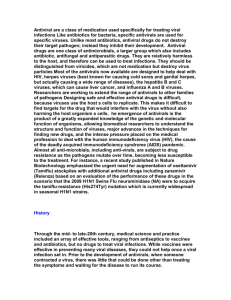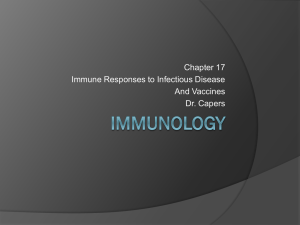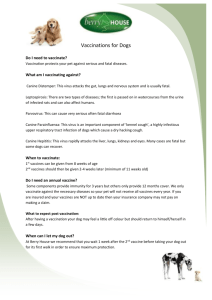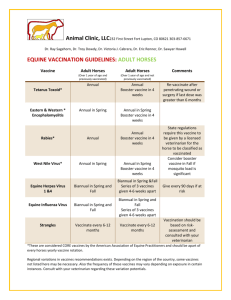Control of Viral Infections and Diseases
advertisement
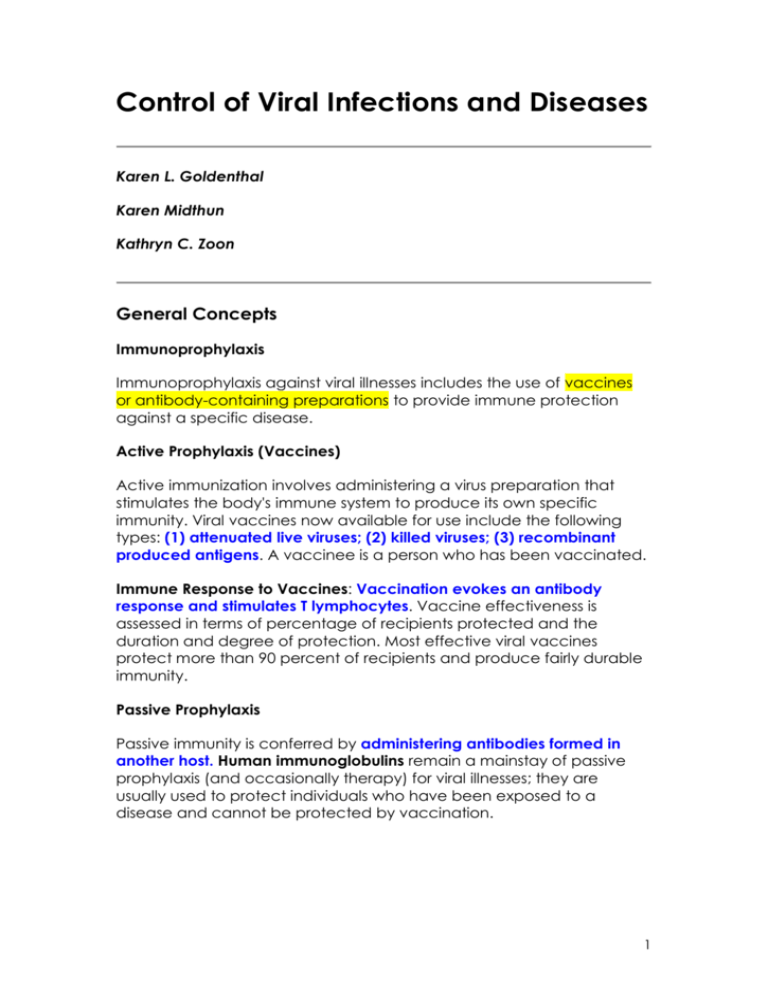
Control of Viral Infections and Diseases Karen L. Goldenthal Karen Midthun Kathryn C. Zoon General Concepts Immunoprophylaxis Immunoprophylaxis against viral illnesses includes the use of vaccines or antibody-containing preparations to provide immune protection against a specific disease. Active Prophylaxis (Vaccines) Active immunization involves administering a virus preparation that stimulates the body's immune system to produce its own specific immunity. Viral vaccines now available for use include the following types: (1) attenuated live viruses; (2) killed viruses; (3) recombinant produced antigens. A vaccinee is a person who has been vaccinated. Immune Response to Vaccines: Vaccination evokes an antibody response and stimulates T lymphocytes. Vaccine effectiveness is assessed in terms of percentage of recipients protected and the duration and degree of protection. Most effective viral vaccines protect more than 90 percent of recipients and produce fairly durable immunity. Passive Prophylaxis Passive immunity is conferred by administering antibodies formed in another host. Human immunoglobulins remain a mainstay of passive prophylaxis (and occasionally therapy) for viral illnesses; they are usually used to protect individuals who have been exposed to a disease and cannot be protected by vaccination. 1 Sanitation and Vector Control Many viral diseases are controlled by reducing exposure to the virus by (1) eliminating nonhuman reservoirs, (2) eliminating the vector, and (3) improving sanitation. Antiviral Chemotherapy There are three types of antiviral agents: (1) virucidal agents, which directly inactivate viruses, (2) antiviral agents, which inhibit viral replication, and (3) immunomodulators, which boost the host immune response. Interferons Virus-infected cells and cells induced with other agents, e.g., doublestranded polynucleotides, can secrete proteins called interferons, which protect normal cells from viral infection. Therapeutic administration of interferon alpha has proven effective for several human viral illnesses. Cytokines Cytokines are molecules produced by cells which modify the biological responses of the same or other cells. INTRODUCTION Viral diseases range from trivial infections to plagues that alter the course of history. Because of the enormous variations in viruses and in their epidemiology and pathogenesis, there is no single, magic-bullet approach to control. Each virus presents its own set of problems. This chapter covers methods useful to various degrees in controlling selected viral diseases. The most spectacular progress so far has involved vaccines. Vector control and sanitation have contributed greatly. Also, a number of therapeutic antiviral agents are now available, including some for very serious infections such as human immunodeficiency virus type 1 (HIV-1) infection. In addition, interferon alpha is now available for the therapy of several viral diseases. 2 Immunoprophylaxis Immunoprophylaxis against viral illnesses includes the use of vaccines or antibody-containing preparations to provide a susceptible individual with immunologic protection against a specific disease. Immunization against viral illnesses can be either active or passive. With active immunity, protection is achieved by stimulating the body's immune system to produce its own antibodies by immunization with a virus preparation. Passive immunity is conferred by administering antibodies formed in another host. For example, an antibody-containing gamma globulin preparation may protect a susceptible individual exposed to a viral illness. Active Prophylaxis (Vaccines) The viral vaccines currently approved for use in the United States are listed in TABLE 51-1. These products are of three types: (1) Attenuated live viral vaccines: Most live vaccines contain viruses that have been attenuated by laboratory manipulation. These attenuated viruses can infect and replicate in the recipient and produce a protective immune response without causing disease. Live attenuated viral vaccines can often confer lifelong immunity after one immunization series. However, because live viruses can multiply in the body, there is always the possibility that they may revert to a more pathogenic form. Adequate laboratory and animal testing and extensive clinical studies must be performed to assess this possibility. In addition, new recombinant technologies facilitate direct alteration of viral genetic structure, thus permitting scientists to produce attenuated viruses in which the genetic regions likely to lead to pathogenic reversion are modified or deleted. (2) Killed (inactivated) viral vaccines: Killed viral vaccines contain either whole virus particles, inactivated by chemical or physical means, or some component(s) of the virus. Completely inactivated viral vaccines cannot cause infection. However, they do not generally produce lifelong immunity following one immunization series; additional doses are usually required. In addition, because killed virus does not multiply in the host, the inoculum itself must provide a sufficiently large concentration of viral antigens to induce the desired immune response. (3) Recombinant-produced antigens: Application of a recombinant DNA strategy to develop new vaccines is performed by identifying the specific component(s) that can elicit the production of protective antibodies, and then cloning and expressing the gene encoding that protein and assembly of a complex in some cases. This approach has made possible a safe and effective recombinant vaccine against 3 hepatitis B virus, which has replaced the vaccine derived from the plasma of hepatitis B virus-infected individuals. Immune Response to Vaccines Vaccination evokes an antibody response which is, in turn, a measure of the effectiveness of the vaccine in stimulating B lymphocytes. Antiviral antibodies are classified as IgA, IgM, or IgG and can be measured by various techniques. Some antibody categories (IgA and IgM) are normally more abundant in respiratory and intestinal secretions; others (mainly IgG) are more abundant in the circulatory system. Vaccines also stimulate T lymphocytes, leading to cell-mediated responses that influence protection. Antibody assays are now routine laboratory procedures, but measuring cellular immunity in vitro usually requires the utilization of complex laboratory techniques. In general, despite the complexities of the immune system, resistance to the vaccine-preventable viral diseases often correlates well with the presence of circulating antiviral antibodies, which are easily measured. Effectiveness is a key concern with any vaccine. Here the standard for comparison is usually the immunity conferred by the natural disease; an example of an exception is rabies. Both epidemiologic and laboratory methods are used to generate comparative data. Vaccine-induced immunity can be defined by the percentage of recipients protected, the projected duration of protection, and the degree of protection. Most viral vaccines considered effective protect more than 90 percent of recipients, and the immunity produced appears to be fairly durable, 4 lasting several years or more. However, vaccines usually do not induce an immunologic response entirely comparable to that seen in the natural disease. Immunity to viral diseases should not be thought of as absolute. Persons immune due to the natural infection, as well as, vaccinees, sometimes experience subclinical reinfection if exposed. Evaluating the protection conferred by a vaccine often involves measuring the frequency and extent to which subclinical reinfection can override vaccine-induced resistance. Often, upon revaccination or reinfection, a boost in IgG antibodies is observed with little or no detectable IgM response, suggesting prior exposure with antibody priming. Such anamnestic responses may be seen in individuals who lack detectable antibody prior to reexposure. Therefore, the absence of measurable antibody may not mean that an individual is unprotected. Immune responses to viral vaccines may be influenced by a number of factors related to the vaccine as well as to the host. As already discussed, the magnitude and duration of immunity differ significantly between live and killed vaccines. The immune response to vaccines can be enhanced by adding adjuvant substances such as aluminum salts (e.g., hepatitis B vaccine). The route of administration of a vaccine can also influence the immunogenicity of some vaccines. Also, maternal antibodies acquired transplacentally can interfere with responses to measles, mumps, and rubella (MMR) vaccine, as demonstrated by lower response rates when the vaccine is administered earlier than 15 months of age. In this case, it is thought that the antibodies interfere with the post-vaccination replication of these live vaccine viruses in the host. Vaccine Production Because viruses are obligate intracellular parasites, all viral vaccines contain substances derived from the cells or living tissues used in virus production. Technical advances have improved production methods. One can think of generations of vaccines: those prepared in the tissues of an inoculated animal are the first generation (e.g., smallpox vaccine from the skin of a calf), products from the inoculation of embryonated eggs are the second generation (e.g., inactivated influenza virus vaccine), and tissue culture-propagated vaccines are the third generation (e.g., poliomyelitis, measles, mumps, and rubella vaccines). 5 The vaccine generation indicates the production methodology, sophistication, and relative purity. Third generation vaccines usually contain the least host protein and other extraneous constituents, but they have been the most difficult to produce. Advances in biotechnology, i.e., recombinant DNA-derived subunit vaccines, now serve as the cornerstone for a fourth generation of vaccines and have led to the development and licensure of a recombinant hepatitis B vaccine. In addition, exciting new technologies such as polynucleotide vaccines are now being tested in animal studies for several viral diseases. Developing new vaccines The past success with developing highly effective viral vaccines has been considerable. To develop a new vaccine, researchers must first identify and then produce the virus (or virus components) in quantity under circumstances acceptable for vaccine preparation. Normally this means production of virus or virus components in cell cultures, embryonated eggs, or tissues of experimental animals or humans, or through nucleic acid recombinant technology. Finding an acceptable production system can be a problem, especially in developing inactivated viral vaccines, because a high concentration of antigen is needed. As already mentioned, production of specific viral proteins by recombinant DNA procedures is providing a solution to many of these problems. A final consideration is the clinical importance of the virus. Normally, it must cause a disease of some severity and there must be an identifiable at-risk target population before consideration is given to developing a vaccine. However, there are still important indications for which there is no effective vaccine. From a public health perspective an important example for which there is no effective vaccine available is human immunodeficiency virus type 1 (HIV-1). Some of the challenges for the development of an HIV-1 vaccine include the following: the type of immune response required to prevent HIV-1 infection is unknown; (2) there is no animal model for AIDS caused by HIV-1; (3) there are multiple types or clades of HIV-1 which may require the development of a multivalent vaccine; (4) even within a clade, there is considerable viral antigen variation; (5) some successful traditional approaches to viral vaccines, such as live attenuated viruses, pose considerable potential safety risks to the vaccinee. 6 Passive Prophylaxis The use of immunoglobulin preparations remains a mainstay of passive prophylaxis (and occasionally of therapy) for viral illnesses. Passive immunoprophylaxis is most often recommended in one of these situations: when exposure has occurred, or is expected to occur very soon, and time does not allow for vaccination and the development of an adequate post-vaccination immune response; (2) when no effective vaccine exists; (3) when an underlying illness precludes a satisfactory response to vaccination. Although once derived exclusively from animal sources, most immunoglobulins are now manufactured from human sources. Table 51-2 lists the types of immunoglobulins approved for use in the United States. Standard immunoglobulin is produced by pooling plasma obtained from thousands of donors and contains antibodies to a number of common viruses. Specific immunoglobulins are produced from donors with high titers of antibodies to specific viruses, often selected following immunization with the relevant vaccine. 7 Sanitation and Vector Control Several early approaches to virus control deserve recognition even though they are less dramatic than vaccination. One approach is the avoidance of viral exposure. This is an effective means of preventing the transmission of HIV-1, which is spread through sexual contact and exposure to blood of infected individuals. Blood bank testing, e.g., for hepatitis B surface antigen and for antibodies to HIV-1, HIV-2, HTLV-I, and hepatitis C, also avoids exposure by identifying and discarding blood units contaminated with these infectious agents. Control of nonhuman viral reservoirs is another early, worthwhile approach. Unfortunately, few opportunities exist for practical application. The most notable success was the control, and in some cases, the elimination of rabies in some countries through removal of stray dogs, quarantine of incoming pets, and vaccination of domestic animals. Another approach of enormous contemporary and historic importance is vector control. Transmission of viral disease by the bite of an arthropod vector was first demonstrated by Walter Reed and his associates, with their discovery that yellow fever was transmitted by mosquitoes. At the turn of the century, yellow fever was a disease of major consequence in the Americas and Africa. By immediately applying Reed's discovery, Gorgas mounted the anti-Aedes aegypti campaign in Havana that marked the beginning of the conquest of epidemic yellow fever. In dealing with the arthropod-borne diseases such as St. Louis encephalitis, any procedure that reduces vector populations or limits the access of the arthropod to humans has potential value. These procedures include draining swamps, applying insecticide, screening homes, and using insect repellant or protective clothing. The last of the older approaches is to improve sanitation. This method is applicable in a limited way to diseases whose epidemiology involves fecal-oral transmission. The well-known link between the discharge of raw sewage into tidal waters, contamination of shellfish, and type A hepatitis is an example of a situation readily reversible by improved sanitary practices. Antiviral Chemotherapy Antiviral chemotherapeutic agents can be divided into three categories: virucidal agents, antiviral agents, and immunomodulators. Virucidal agents directly inactivate intact viruses. Although some of these agents have clinical usefulness (e.g., topical treatment 8 of warts with podophyllin, which destroys both virus and host tissues), most virucides have no demonstrated therapeutic value. Antiviral agents inhibit viral replication at the cellular level, interrupting one or more steps in the life cycle of the virus. These agents have a limited spectrum of activity and, because most of them also interrupt host cell function, they are toxic to various degrees. The emergence of drug resistant viruses may occur during clinical use that further limits the effectiveness of various antivirals. and several are under investigation. Immunomodulators such as interferons that alter the host immune responses to infection could, in principle, be protective, A number of antiviral agents with demonstrated effectiveness are now available (TABLE 51-3). These antiviral agents improve the clinical course of disease, but typically have important limitations especially as therapeutics for chronic or latent infections. For example, the four nucleoside analog drugs now available for the therapy of HIV-1 do not prevent the ultimate worsening of disease. The concept of a targeted approach is now practical since information concerning the structure and replication of viruses and the spatial configuration and function of their proteins is available. Such data may be useful in identifying specific target sites for antiviral agents. 9 10 Interferons: Cytokines With Antiviral Activity Since the mid-1930s, scientists have recognized that under certain circumstances one virus can interfere with another. In 1957, Isaacs and Lindenman made a dramatic discovery that explained the mechanism of resistance. They found that virus-infected cells can elaborate a protein substance called interferon, which, when added to normal cells in culture, protects them from viral infection. Other microbial agents (such as rickettsiae and bacteria) and natural and synthetic polypeptides were later shown to induce interferon. There are three types of interferon: alpha, beta and gamma. Interferon alpha is produced by leukocytes, interferon beta is produced predominantly by fibroblasts and interferon gamma is produced by activated lymphocytes. Interferons tend to exhibit species specificity (mouse cell interferon protects mouse cells to a much greater extent than human cells) and are inhibitory to numerous viruses. For many years it was not possible to obtain sufficient quantities of interferons to conduct major studies. However, recombinant DNA technology and cell culture technology led to the production of adequate supplies of interferons and the subsequent conduct of extensive clinical trials. Although broadly antiviral in some animal models, interferon alpha has proven effective in a limited number of viral illnesses of humans, including chronic hepatitis B and C and refractory condylomata acuminata. In addition, interferons have been effective in the treatment of other diseases. For instance interferon alpha is effective for hairy cell leukemia and AIDS-related Kaposi's sarcoma in a selected group of individuals; interferon beta for relapsing-remitting multiple sclerosis; and interferon gamma for reducing the frequency and severity of serious infections associated with chronic granulomatous disease. Identifying New Effective Therapeutics The improved basic science knowledge base of viruses combined with the urgent need for improved therapeutics, especially for HIV-1, has given considerable impetus to the search for new approaches. Some approaches under investigation that may lead to future approved therapies are described here: Combination Therapy: The use of multiple drugs with different mechanisms of action is being studied as a method of improving clinical effectiveness. Such combinations may offer advantages over monodrug therapy such as improved antiviral activity, preventing or delaying the development of drug resistance, and use of lower, less toxic doses. Combinations of various antiviral agents have been extensively studied for HIV. In addition, approaches investigated for HIV 11 have included combining a cytokine with one or more antiviral agents. Combination therapy has been effective in the treatment of diseases caused by other infectious agents (e.g., Mycobacterium tuberculosis and Pseudomonas aeruginosa). Discovering New Drugs: New drugs with novel mechanisms of action are being sought and developed. Some of these have displayed considerable antiviral activity in human clinical trials, e.g., protease inhibitors for HIV-1. Evaluating Available Drugs for New Indications: Interleukin-2, a cytokine currently approved for treating renal cell carcinoma, has shown considerable immunomodulatory activity in some HIV-1 infected patients in early human studies. REFERENCES Bauer DJ: A history of the discovery and clinical application of antiviral drugs. Br Med Bull 41:309, 1985 Centers for Disease Control. General recommendation on immunization: recommendations of the Advisory Committee on Immunization Practices (ACIP). MMWR 43 (no. RR-1):1, 1994 Centers for Disease Control. Hepatitis B virus: a comprehensive strategy for eliminating transmission in the United States through universal childhood vaccination: recommendations of the Immunization Practices Advisory Committee (ACIP). MMWR 40 (no. RR-13):1, 1991 Hayden FC: Antiviral Agents. p. 411. In Mandell GL, Bennett JE, Dolin R (eds): Principles and Practice of Infectious Diseases. 4th Edition, Churchill Livingstone Inc. N.Y., N.Y., 1995 Hilleman MR: Newer directions in vaccine development and utilization. J Infect Dis 151:407, 1985 Kovacs JA, Baseler M, Dewar RJ, Vogel S, Davey RT, Falloon J, Polis MA, Walker RE,Stevens R, Salzman NP, Metcalf JA, Masur H, Lane HC: Increases in CD4 T lymphocytes with intermittent courses of interleukin-2 in patients with human immunodeficiency virus infections. NEJM 332: 567, 1995. Mitsuya H, Broder S: Strategies for antiviral therapy in AIDS. Nature (London) 325:773, 1987 Newton AA: Tissue culture methods for assessing antivirals and their harmful effects. p. 23. In Field HJ (ed): Antiviral Agents: The 12 Development and Assessment of Antiviral Chemotherapy. Vol 1. CRC Press, Boca Raton, FL, 1988 Plotkin SA, Mortimer EA, Jr: Vaccines. 2nd Edition. W.B. Saunders Co, Philadelphia, 1994 Spooner KM, Lane HC, Masur H: Antiretroviral therapy: reference guide to major clinical trials in patients infected with human immunodeficiency virus. Clin Infect Dis 20:1145, 1995 Zoon KC: Human Interferons: Structure and Function. p. 1-12. In: Interferon 8. Academic Press, London, 1987 Zoon KC, Miller D, Bekisz J, zur Nedden D, Enterline JC, Nguyen NY, Hu RQ: Purification and characterization of multiple components of human lymphoblastoid interferon alpha. J Biol Chem 267: 15210, 1992 13
